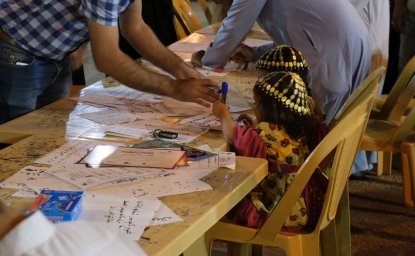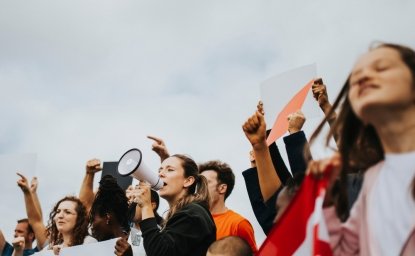The Women's Movement in Iran
In this chapter from The Iran Primer, Haleh Esfandiari provides an historical overview of the women's movement in Iran.
In this chapter from The Iran Primer, Haleh Esfandiari provides an historical overview of the women's movement in Iran.
Overview
Iranian women made considerable progress during the Pahlavi era (1925-1979). Education for both girls and boys was free. When Tehran University opened in 1936, Iran’s first university admitted both men and women. In 1963, women acquired the right to vote and run for parliament. Under the Family Protection Law, women won the right to petition for divorce and gain child custody. A husband could no longer unilaterally divorce his wife or automatically gain custody of the children. The marriage age for girls was raised from 13 to 18. And men needed the court’s permission to take a second wife. By 1978, on the eve of Iran’s revolution, 22 women sat in parliament and 333 women served on elected local councils. One-third of university students were female. Two million women were in the work force, more than 146,000 of them in the civil service.
The 1979 revolution politicized the mass of Iranian women. But women’s expectations were not realized. The new theocracy systematically rolled back five decades of progress in women’s rights. Women were purged from government positions. All females, including girls in first grade, were forced to observe the hejab, or Islamic dress code. Family laws were scraped. For the next three decades, however, the energy Iranian women displayed during the revolution propelled them deeper into the public arena to regain their rights. The result is one of the most dynamic women’s movements in the Islamic world, and female activists who have won international recognition in a wide array of professions.
The Khomeini decade 1979-1989
Under revolutionary leader Ayatollah Ruhollah Khomeni, Iran’s new theocracy gave priority to Islamic tradition over modern mores.One of the revolutionary government’s first acts was to suspend the Family Protection Law and dismantle Family Courts. Men were once again free to divorce their wives by simple declaration; they also gained exclusive custody of their children. Women could no longer file for divorce unless the right was stipulated in marriage contracts, and they lost the right to child custody. Restrictions on polygamy were also removed. The marriage age for girls was reduced to puberty, which is nine under Islamic law. In 1981, parliament approved the Islamic Law of Retribution, introducing flogging, stoning and payment of blood money for crimes ranging from adultery to violation of Islamic dress codes.
Professionally, women were slowly pushed into traditional female fields, such as teaching and nursing. Women were barred from becoming judges. Government–run day care centers were closed, making it difficult for women to stay in jobs anyway. At universities, the idea of segregating women and men was soon abandoned as impractical, but it took several years before bars were removed on certain fields of education—in turn affecting job prospects.
Politically, women held on to the right to vote and run for parliament. Four women were elected to the first parliament in 1980, and later sat on local councils. But most women in decision-making positions were either dismissed, given early retirement, or demoted. A decade passed before the first woman was named deputy minister, 17 years passed before a woman was appointed vice president, and 30 years passed before the Islamic Republic named its first female minister. The constitution bars women from the position of supreme leader – the highest post in the country—but does not stipulate the gender of the president or cabinet members. Women have tried to run in presidential elections, but they have all been disqualified.
On social issues, the theocracy’s initial policies were harsh. Hejab, or Islamic dress and head cover, was forcibly imposed. Showing a bit of hair became punishable, with penalties ranging from heavy monetary fines to 70 lashes. The regime also attempted to segregate men and women in public places, but did not succeed. But the eight-year Iran-Iraq War (1980-1988) had a galvanizing influence on the status of women. Women were drawn into the work force as nurses, doctors and support for soldiers on the war front. In the absence of men, many women became the family bread winners. During the revolution’s first decade, women in the work force fell from about 13 percent to 8.6 percent.
The Rafsanjani presidency 1989-1997
After the war, women became pivotal politically. They voted in substantial numbers for Akbar Hashemi Rafsanjani for president in 1989, and again in 1993 because he was pragmatic on women’s issues. Rafsanjani gradually eased social controls. Women were harassed less on the streets. They benefited from minor changes in the personal status law and were able to participate in international sports competitions. The number of girls in schools and universities soared.
Rafsanjani also reversed the Islamic Republic’s policy of encouraging large families and launched a family planning program to curb Iran’s alarmingly rapid rate of population growth. The success of this program is one of the IslamicRepublic’s most striking achievements. The total fertility rate (the average number of births per woman) dropped from 5.6 in the early 1980s to 2.0 in 2000, and to 1.9 births per woman in 2006. The decline has been particularly impressive in rural areas where the average number of births per woman dropped in one generation from 8.1 to 2.1. As a result, the annual rate of natural population increase declined from 3.2 percent in early 1980s to 1.8 percent in 2006.
The Khatami years 1997-2005
Women fared even better during the presidency of Mohammad Khatami. Riding on a wave of pro-reform sentiment, he appointed a handful of women to prominent posts. Among them: Masoumeh Ebtekar was his vice president for the environment and Zahra Rahnavard became the first woman chancellor of an Iranian university. In 2004, 13 women were elected to parliament—the largest number since the revolution.
Under Khatami, women also scored several legal victories. Pressure from women led the government to reintroduce modified parts of the suspended Family Protection Law. Women judges became special advisors to presiding clerics on special family courts. In 1994, parliament enacted a law awarding a woman monetary compensation when her husband initiated divorce proceedings and she was not at fault. In 2002, parliament raised the age of marriage for girls from nine to 13. The ban on unaccompanied single women studying abroad on government scholarships was also lifted. Khatami’s presidency also saw the burgeoning of non-government organizations that laid the foundation for a more vibrant civil society. Many were founded around women’s issues.
The Ahmadinejad years 2005 -
Mahmoud Ahmadinejad struggled to balance rival trends at a time women carried growing weight at the ballot box. He faced deepening resolve among hardliners to curb the female quest for full equality; he was also confronted by public pressure from women not to be relegated to second-class status again.
Under hardliners, women generally fared poorly on several fronts. The momentum for change built up over the previous 16 years virtually evaporated. The government closed down Zanan, the country’s leading feminist magazine. In 2007 elections, only 43 women were elected to local councils out of tens of thousands of seats. In the 2008 parliamentary elections, the only two reformist women in parliament were voted out. Of 7,168 candidates, 585 were women, but only nine were elected. Police cracked down on women for dress code violations. Ahmadinejad also called on women to have more children.
In the June 2009 presidential campaign, tens of thousands of women from all social classes supported the two reformist candidates who backed greater women’s rights. For the first time, candidates had women advising and campaigning for them in public. After the election, Ahmadinejad lost the support of a large number of conservative women because of atrocities committed by the security forces against protesters. He was noticeably silent on the trials and harsh on the sentencing of women, allegations of rape and torture of detainees, and the mistreatment of women protesting the detention of relatives.
After his reelection, Ahmadinejad nominated three women to his cabinet. But only one of his nominees, Marzieh-Vahid Dastjerd as minister of health, was approved by parliament because of objections by a number of leading clerics and conservative politicians.
Factoids
Prominent women
The Future


The Wilson Center’s Middle East Program serves as a crucial resource for the policymaking community and beyond, providing analyses and research that helps inform US foreign policymaking, stimulates public debate, and expands knowledge about issues in the wider Middle East and North Africa (MENA) region. Read more



